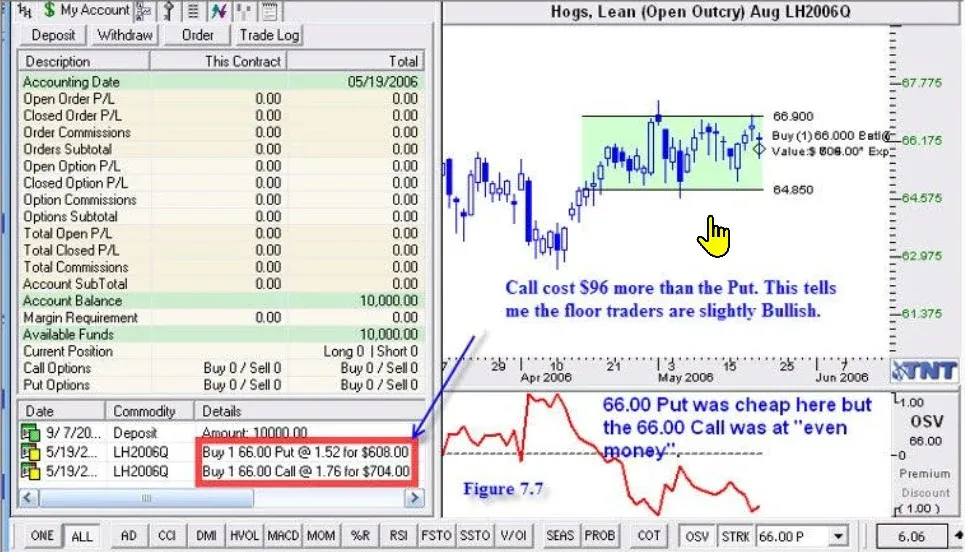Straddle
Straddle
A long Straddle is placed when you are looking for a large price breakout in either direction. These work better in volatile markets than in non-volatile markets.
I’m also going to cover various trade adjustments you can do to manage the trade as it progresses, but I will do this in a later chapter.
A Long Straddle consists of buying an equal number of Calls & Puts at the same strike price. Adding additional Calls & Puts at the same strike price creates something called a Strap or a Stripe depending upon if you add more Calls or more Puts. More Calls is a Strap and more Puts is a Strip.
Since a Strap has more Calls than Puts it’s more of a Bullish position. If you have more Puts than Calls, then it’s a Strip and it’s more of a Bearish position.
Remember there is no margin required on these trades since you are buying, not selling both the Call and the Put.
It goes without saying that since you are buying, not selling the options, the price of the option must be cheap! I did not say “deep-out-of-the money,” I said “cheap” as in underpriced. Not doing this can put your account in the toilet quickly!

This also means that you will have to be patient before you can find a trade with a good chance of making a profit. Keep in mind that options become cheap in trading ranges and even cheaper in Channels.
Setting Risk/Reward Ratios can be a challenge also. A good rule of thumb is to exit the trade once you have doubled the amount you are risking. So, let’s say that you are only going to risk $500 then get out when you have made $1,000. There of course are exceptions to this. Something else to consider is that you can offset the Put if the market takes off and heads up quickly or offset the Call if the market takes a quick dive down.
Don’t stay in these trades longer than you need to. What you are looking for is a big breakout in one direction or the other. If that doesn’t happen, then it’s probably best to get out of the trade with either a small loss or a small profit.
You might be wondering why we did not look at buying out-of-the-money Puts & Calls. Got your thinking caps on?
Good! It’s because out-of-the-money Puts & Calls have more time decay than in-the-money Puts & Calls. And since you are buying the same strike price on both the Put and the Call you want the least amount of time decay possible. If you think about it for a minute, it makes sense. So, stop and think about it for a minute!

Let’s look at Figure 7.7 and see what we can do.

You can see that I have chosen the strike price of 66.00 which is right in the middle of the Trading Range on this Aug. 06 Lean Hogs contract. Also notice in the red box the Call cost $96.00 more than the Put. This is telling me the floor traders are a little more Bullish than they are Bearish. And this is due to the recent rally, just before it started trading sideways. Right now, I’m sure you are thinking that you could use this knowledge in several different ways. If so, I’m very proud of you because you are correct.
Now, the cost of putting this trade on is $608.00 + $704.00 which is of course $1,312. But we don’t have to risk all of that. We are only going to risk $500 or 5% of our $10,000 trading account. Also, there is no margin required since we are buying, not selling, these options. What is our game plan here? We are going to exit the trade if it goes against us by $500 and we are going to make profits of $1,000 if we can. And, if this doesn’t happen soon then we are also going to get out of the trade. There is no sense in letting all that money get tied up in a trade that’s not working for us in either direction.
In figure 7.8 you can see that price at first came down and then the last few days shot back up very quickly. Our account is now up to $704, and this includes commissions of $100. We should now wait a few days and see if this rally holds. If it does, then we can decide what to do.


In Figure 7.9 you will see the account is up to $1,004 and this is after commissions since it’s built into the software to deduct commissions in the accounting plug-in. We have several choices or should I say options at this time. One choice is that we can exit the trade and take a $1,004 profit. What else could we do? Go get your thinking caps!

Remember earlier we discussed a Bull Call Spread? This is where you buy a Call and sell a further out Call. Well, if we sold the Put (for a loss) and sold a further out Call, we would be doing what is called “rolling into” a Bull Call Spread! Selling the Put is not part of the “rolling in process” by the way. So, let’s look at what could happen if we did this.
First, we would take a loss on the Put we purchased if we offset it. Now we paid $608 for the Put and it’s still worth $544. So, we only lose $54 on the Put ($608-$544!) Why is it still so expensive? I can sum it up in one word – Volatility! You can see in Figure 7.10 what the premium is on the Put.

So, if we offset the Put and we are still long one Call, right? In Figure 7.11, you can see the 72.00 Call is selling for $508. So, let’s buy back (offset) our Put for a loss of $54, sell the 72.00 Call for $628 and collect the premium.
Now if the market comes back down, we protected some of our profits by selling the Call and if it goes up our long Call is going to increase in value faster than our short Call. Now part of our plan will be that if the market does in fact rally and hit 72.00 then we should probably exit the trade and take our profits. Also notice that we are up over $1,000 on this trade.


So, what we have done is rolled into a Bull Call Spread and you already know how they work, don’t you? Say “yes.” Whew… I thought for a moment you might have forgotten.
Look at Figure 7.12 and see what happened. We took profits of $1,464 on this trade and the biggest drawn down was the third day of the trade and it was only about $200. Don’t you love options?

Watch The Video
